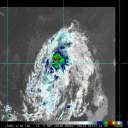Show Selection:
|
#898257 (Received by flhurricane at: 5:08 AM 13.Aug.2017)
TCDAT3
Tropical Depression Eight Discussion Number 2
NWS National Hurricane Center Miami FL AL082017
500 AM EDT Sun Aug 13 2017
Satellite-derived winds from ASCAT passes at 0122Z and 0208Z
indicated that the tropical depression had a closed surface
circulation with peak winds of 33 kt in the southeastern quadrant.
However, those peak winds were occurring in the same area of the
circulation where NOAA Buoy 41046, which several hours ago measured
a sustained wind of 35 kt and a peak gust to 43 kt, due to what
appears to have been cold, downdraft-driven wind gusts based on a
sharp decrease in the temperature and dew point values. As a result,
the intensity will be held at 30 kt for this advisory, in line with
a consensus 30-kt estimate from TAFB, SAB, and UW-CIMSS ADT.
The initial motion estimate is 335/12 kt. The depression is forecast
to move north-northwestward to northward for the next 36 h around
the western portion a deep-layer subtropical ridge that is oriented
east-west along 30-32N latitude. By 48 h and beyond, a vigorous
shortwave trough currently located over the northern Plains is
expected to dig east-southeastward and weaken the ridge along the
east coast of the United States from the Carolinas northward to New
England. The increasing southwesterly flow ahead of the trough is
forecast to accelerate the cyclone northeastward, on an optimal
track about midway from the U.S. and Bermuda and keeping it away
from those two land masses. The new NHC tack forecast is similar
to the previous advisory, and lies close to a blend of the HCCA and
TVCN consensus track models.
The depression is expected to remain in a relatively low vertical
wind shear environment for the next 24-36 hours, but also within a
fairly dry mid-level moisture environment for the duration of the
forecast. As a result, only modest strengthening is expected during
the next couple of days. By 48 h and beyond, southwesterly vertical
wind shear is expected to steadily increase to more than 20 kt ahead
of the aforementioned shortwave trough, reaching 40-50 kt by 96-120
h, which should act to cap any additional intensification. Owing to
the strong shear, the cyclone is forecast to become extratropical by
days 4 and 5. The official intensity forecast is similar to the
previous advisory, and lies close to the consensus models IVCN and
ICON. The intensity forecast at 96 and 120 h reflects guidance
provided by the NOAA Ocean Prediction Center.
FORECAST POSITIONS AND MAX WINDS
INIT 13/0900Z 26.5N 70.9W 30 KT 35 MPH
12H 13/1800Z 28.1N 71.7W 35 KT 40 MPH
24H 14/0600Z 29.9N 72.2W 40 KT 45 MPH
36H 14/1800Z 31.5N 72.0W 45 KT 50 MPH
48H 15/0600Z 33.4N 71.0W 50 KT 60 MPH
72H 16/0600Z 37.7N 64.1W 50 KT 60 MPH
96H 17/0600Z 42.4N 50.8W 45 KT 50 MPH...POST-TROP/EXTRATROP
120H 18/0600Z 46.3N 36.5W 45 KT 50 MPH...POST-TROP/EXTRATROP
$$
Forecaster Stewart |



